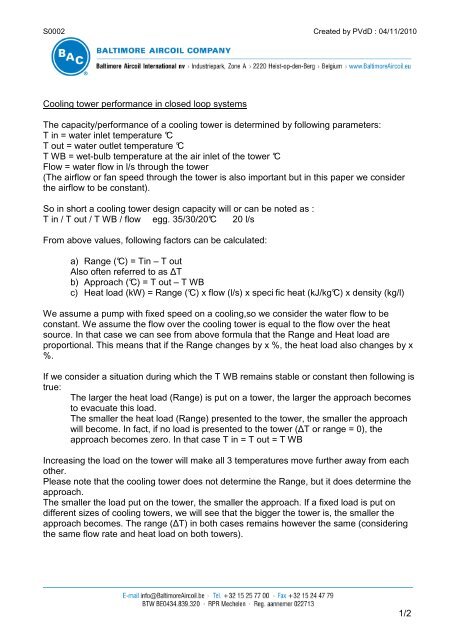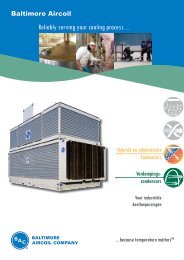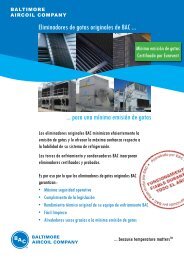Cooling tower performance in closed loop sytems - Baltimore Aircoil ...
Cooling tower performance in closed loop sytems - Baltimore Aircoil ...
Cooling tower performance in closed loop sytems - Baltimore Aircoil ...
You also want an ePaper? Increase the reach of your titles
YUMPU automatically turns print PDFs into web optimized ePapers that Google loves.
S0002 Created by PVdD : 04/11/2010<br />
<strong>Cool<strong>in</strong>g</strong> <strong>tower</strong> <strong>performance</strong> <strong>in</strong> <strong>closed</strong> <strong>loop</strong> systems<br />
The capacity/<strong>performance</strong> of a cool<strong>in</strong>g <strong>tower</strong> is determ<strong>in</strong>ed by follow<strong>in</strong>g parameters:<br />
T <strong>in</strong> = water <strong>in</strong>let temperature °C<br />
T out = water outlet temperature °C<br />
T WB = wet-bulb temperature at the air <strong>in</strong>let of the <strong>tower</strong> °C<br />
Flow = water flow <strong>in</strong> l/s through the <strong>tower</strong><br />
(The airflow or fan speed through the <strong>tower</strong> is also important but <strong>in</strong> this paper we consider<br />
the airflow to be constant).<br />
So <strong>in</strong> short a cool<strong>in</strong>g <strong>tower</strong> design capacity will or can be noted as :<br />
T <strong>in</strong> / T out / T WB / flow egg. 35/30/20°C 20 l/s<br />
From above values, follow<strong>in</strong>g factors can be calculated:<br />
a) Range (°C) = T<strong>in</strong> – T out<br />
Also often referred to as ∆T<br />
b) Approach (°C) = T out – T WB<br />
c) Heat load (kW) = Range (°C) x flow (l/s) x speci fic heat (kJ/kg°C) x density (kg/l)<br />
We assume a pump with fixed speed on a cool<strong>in</strong>g,so we consider the water flow to be<br />
constant. We assume the flow over the cool<strong>in</strong>g <strong>tower</strong> is equal to the flow over the heat<br />
source. In that case we can see from above formula that the Range and Heat load are<br />
proportional. This means that if the Range changes by x %, the heat load also changes by x<br />
%.<br />
If we consider a situation dur<strong>in</strong>g which the T WB rema<strong>in</strong>s stable or constant then follow<strong>in</strong>g is<br />
true:<br />
The larger the heat load (Range) is put on a <strong>tower</strong>, the larger the approach becomes<br />
to evacuate this load.<br />
The smaller the heat load (Range) presented to the <strong>tower</strong>, the smaller the approach<br />
will become. In fact, if no load is presented to the <strong>tower</strong> (∆T or range = 0), the<br />
approach becomes zero. In that case T <strong>in</strong> = T out = T WB<br />
Increas<strong>in</strong>g the load on the <strong>tower</strong> will make all 3 temperatures move further away from each<br />
other.<br />
Please note that the cool<strong>in</strong>g <strong>tower</strong> does not determ<strong>in</strong>e the Range, but it does determ<strong>in</strong>e the<br />
approach.<br />
The smaller the load put on the <strong>tower</strong>, the smaller the approach. If a fixed load is put on<br />
different sizes of cool<strong>in</strong>g <strong>tower</strong>s, we will see that the bigger the <strong>tower</strong> is, the smaller the<br />
approach becomes. The range (∆T) <strong>in</strong> both cases rema<strong>in</strong>s however the same (consider<strong>in</strong>g<br />
the same flow rate and heat load on both <strong>tower</strong>s).<br />
1/2
S0002 Created by PVdD : 04/11/2010<br />
Conclusion:<br />
- To check if a cool<strong>in</strong>g <strong>tower</strong> is perform<strong>in</strong>g as it should be, one should check if the<br />
approach measured on the <strong>tower</strong> corresponds with the expected approach (related to<br />
the load put on it)<br />
- In other words: theoretically a cool<strong>in</strong>g <strong>tower</strong> can reject any heat load presented to it,<br />
but not at the same approach.<br />
o a smaller <strong>tower</strong> (or bad designed or polluted <strong>tower</strong>) will require a big approach<br />
o a big <strong>tower</strong> will have a small approach<br />
The ∆T is not determ<strong>in</strong>ed by the <strong>tower</strong>, but by the presented cool<strong>in</strong>g load.<br />
- The cool<strong>in</strong>g <strong>tower</strong> will adapt the approach until it is able to meet exactly the presented<br />
cool<strong>in</strong>g load. If the load is <strong>in</strong>creased the approach will <strong>in</strong>crease and vice versa.<br />
- Please note that the approach is <strong>in</strong> function of the wet-bulb temperature. At lower wetbulb<br />
temperatures, larger approaches are needed to reject the same cool<strong>in</strong>g load as<br />
on higher WB temperatures.<br />
The heat load (and the water flow) determ<strong>in</strong>es the ∆T (Range). The size of the <strong>tower</strong><br />
and the airflow through it determ<strong>in</strong>e how high the temperature will be above the wetbulb<br />
temperature (approach).<br />
Paul Van den Driessche<br />
Service Manager<br />
<strong>Baltimore</strong> <strong>Aircoil</strong> International N.V.<br />
Industriepark-Zone A<br />
B-2220 Heist op den Berg, Belgium.<br />
Tel: +32 (0)15 25 77 25<br />
Fax: +32 (0)15 25 78 25<br />
pvandendriessche@<strong>Baltimore</strong><strong>Aircoil</strong>.be<br />
2/2





